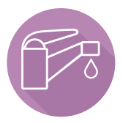Your water bill is calculated in CCFs. A CCF is 100 Cubic Feet of water, or 748 gallons. An unusually high water bill is typically caused by a change in water use or a leak. Some common causes of high water bills include:
- A leaking toilet, or a toilet that continues to run after being flushed.
- A dripping faucet; a faucet drip can waste 20 gallons or more a day.
- Filling or topping off a swimming pool or hot tub.
- Watering the lawn, new grass or trees.
- Children home for summer vacations or school holidays or house guests.
- A broken water pipe or obvious leak.
The RWA issues bills on a monthly basis, and the cause of an increase in water usage may not always be immediately apparent. If you have a high bill and do not have a leak, did you have house guests, water your lawn more than usual or do anything else out of the ordinary that uses a lot of water?
You can monitor your water usage and gain insight into how and when you use water using our online Water Watch tool, accessible from our RWA Connect online account portal. Water Watch can help you identify the times where you consume the most water and detect possible leaks before they cause damage to your home or leave you with a high bill.
If you have reviewed your bill and still have questions on the amount due or the usage being charged, contact us at 203-562-4020 or by writing ask.billing@rwater.com. The RWA also offers a Residential Water Assistance program for qualified individuals who need help paying their water bill.

Find Your Water Meter
Your water meter is the best detective for finding leaks in your home. The meter is usually located in the basement behind the cellar wall valve or near the street in a vault.

Check for Leaks
- Make sure no water is being used inside or outside of your house. Don't forget to check automatic ice makers and sprinkler controllers.
- Check the leak indicator on your water meter to see if it is moving. Depending on the brand of your meter, the leak indicator will be a small dial that rotates when water is flowing through the meter. If the dial is moving, chances are, you have a leak.
- Or, you can also take a meter reading and wait one or two hours and take another meter reading (make sure no water is used during this time). If the reading has changed, you have a leak.

Outdoor and Underground Leaks
One of the biggest sources of high water bills is the use of an irrigation system. An average sprinkler head can use two gallons per minute. If your system has 20 heads, and runs for 20 minutes each day, the result would be 24,000 gallons in a month. To monitor your water usage for irrigation, take a reading at the start of a watering cycle and again at the end. This way you will know exactly how much water your system is using. Based on this information, you can adjust your watering accordingly.


